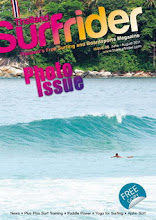Having previously ridden Starboards 9’8, 10’, 10’5, 11’2, 12’ and 14’8 Stand Up Paddleboards the first noticeable difference was the weight, size and overall bulk of the Pocket Rocket, its a lightweight pocket sized SUP. It's a more manageable board size, it fits into the tray of my truck nicely, it can be loaded onto a roof rack by one person easily and I don’t have to switch arms carrying it down to the beach.
Next thing that struck me was the radical shape of the Pocket Rocket, a single to double concaved stinger with plenty of nose, tapering down into a pulled quad finned swallow tail…a veritable sex machine. This combination of length and crafted design culminates into a paddleboard with unique performance characteristics.
Short, wide and chunky, the stats list at 126 litres volume, 8'5" in length, 30" wide by 4.3" thick with a 19" tail width. Moving down to a shorter length took a little getting used to but after a few quick adjustments it soon felt very comfortable.
Paddling on flat water the Pocket Rocket is surprisingly stable. The Pocket Rocket doesn’t have the same effortless glide as longer paddleboards and it won’t track as straight, however it does feel equally as solid underfoot. Although I wouldn’t recommend this as a beginners model, I have placed first timers on this paddleboard and they’ve taken to it within minutes.
I’ve been having so much fun surfing this model in a variety of small wave conditions, and it's not until you take the Pocket Rocket into the surf and pull into that first wave that you really begin to understand how the design features come into play.
The shorter length makes it easy to spin around into position quickly and it fits better into smaller wave shapes than the longer boards. The nose has plenty of surface area to paddle in early, and once it starts to glide, a slight transfer of weight over the back foot opens up the Pocket Rocket’s quick turning ability giving it a loose fun-board feel. This sweet spot between the nose and tail sections gives the Pocket Rocket its fine balance between fast acceleration and responsive bite into a turn.
I’ve not yet had the opportunity to try this paddleboard in bigger waves but I feel confident the Pocket Rocket was built to handle size and she will be accompanying me on a trip to Indo very shortly to prove herself.
There’s a good reason why this is currently the best selling sub 9’ SUP in the world. For a rider looking for a dedicated all wave type, all conditions surfing SUP, it’s a hard choice to beat. I really found the love for the 8’5 Pocket Rocket and it’s pumped my stoke for SUP, a definite addition to the quiver. In conclusion all I have to say is go buy one, ride it and cherish this baby.
Again, a huge thank you to Amara Watersports for their constant encouragement and for giving us the opportunity to test drive this beauty!




































